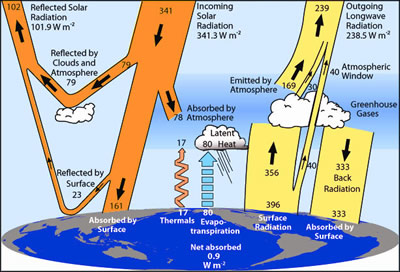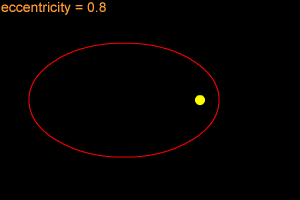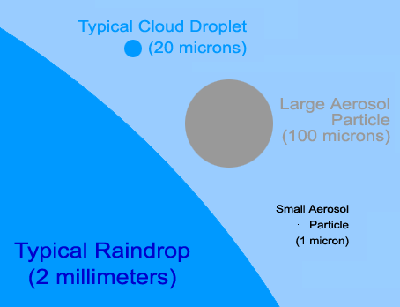Click on image for full size
Trenberth, K.E., J.T. Fasullo, and J. Kiehl, 2008: Earth's global energy budget. Bull. Amer. Meteor. Soc., submitted.
Atmospheric Science Literacy - Essential Principle 2
Energy from the Sun drives atmospheric processes.
Fundamental Concept 2.1
Earth receives energy in the form of electromagnetic radiation from the Sun. Some of this solar energy is absorbed by the atmosphere, some is scattered back to space, and some is transmitted through the atmosphere to be absorbed or reflected by Earth's surface. The solar energy reflected by Earth's surface is absorbed, scattered, or transmitted by the atmosphere.
Fundamental Concept 2.2
Energy from the Sun is transformed into other forms of energy in the Earth System. In the atmosphere these other forms include thermal energy of gas molecules, the kinetic energy of wind, and the latent heat of evaporation stored in water vapor.
Fundamental Concept 2.3
On human time scales, the energy emitted by the Sun is nearly constant, varying only very slightly due to solar activity. The amount of solar energy received at a point on Earth's surface varies due to Earth's spherical shape, its daily rotation about its tilted axis, its annual revolution around the Sun, and the slight elliptical shape of Earth's orbit, leading to important cycles such as day and night, and the seasons. In addition, cloud cover and aerosols can reduce the amount of solar energy that reaches Earth's surface.
Fundamental Concept 2.4
Solar energy drives many chemical, biological, and physical processes that affect Earth's atmosphere. These include processes such as photosynthesis, evaporation of liquid water to produce water vapor, formation of smog, and the formation and destruction of ozone.
Fundamental Concept 2.5
Earth also emits energy in the form of electromagnetic radiation. Almost all of the energy emitted comes from the solar energy absorbed by Earth's surface. This terrestrial energy is absorbed by atmospheric trace gases, such as water vapor, carbon dioxide, and other gases in Earth's atmosphere. It may be reemitted from the atmosphere, either to space, where it is lost to the Earth System, or back to Earth, where it is again absorbed, producing a "Greenhouse Effect". This natural Greenhouse Effect is necessary for life to exist on Earth.















